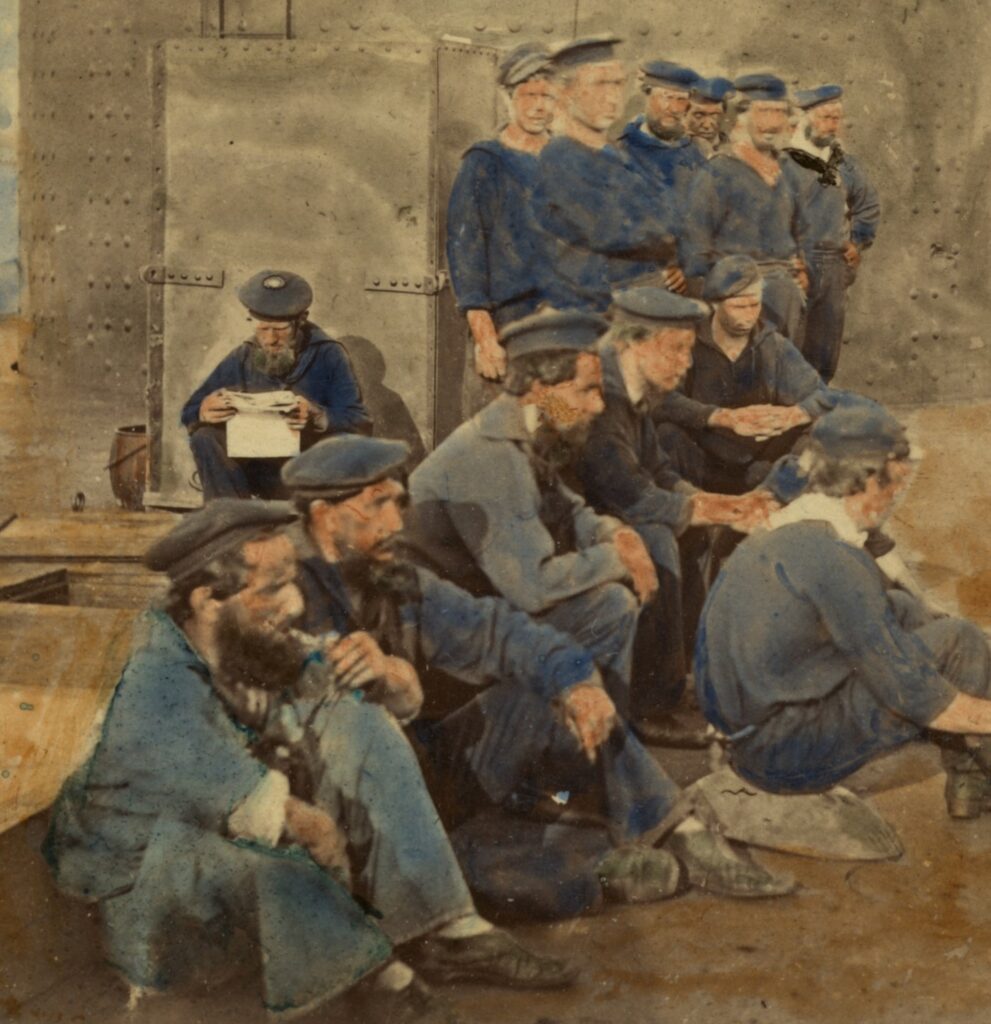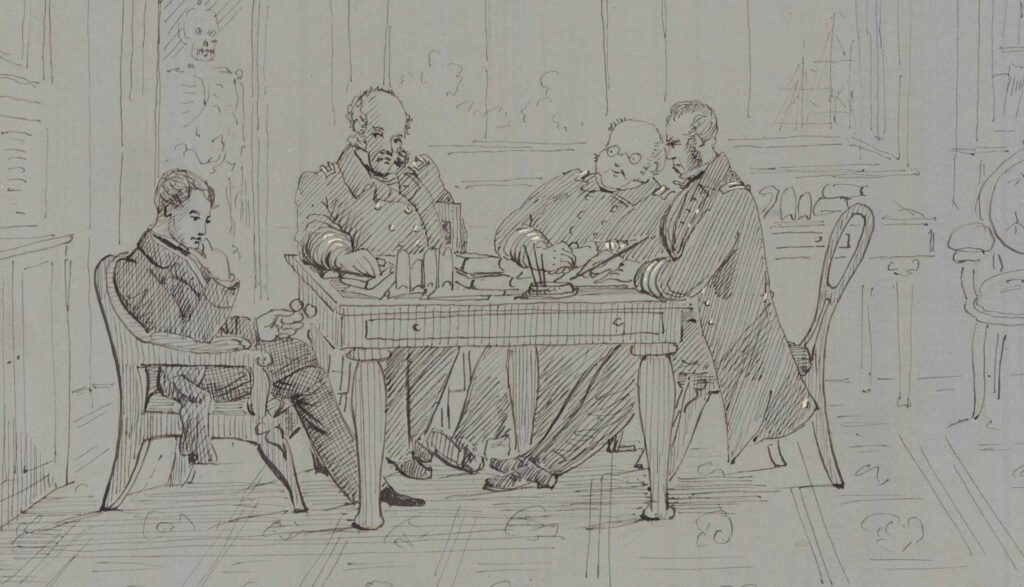
William Frederick Keeler, Acting Paymaster of the USS Monitor felt perfectly safe in the new ironclad. But that was part of the problem: “There isn’t even danger enough to give us any glory.”[1] Keeler’s distress was that he and his crewmates’ efforts would go unrecognized. He feared that while the sailors and marines signed up for guts and glory, they would have an easy time of it. Meanwhile their comrades in the U.S. Army were dying gloriously on battlefields across the continent, and their sacrifice was earning them a permanent place in the American pantheon of heroes. Without mortal danger, Keeler and other mariners like him worried that they couldn’t rightfully claim the same laurels.

This might seem obvious in the abstract, but suffering massive casualties is not directly correlated to success. The United States Navy was essential to victory in the Civil War. Their story is often overshadowed because they did not have the same experiences as their comrades in the Army, especially when it came to combat and casualties.
Recent scholarship has begun to give the Navy their due. In keeping with that trend, I began to wonder at some anomalies of naval casualties. Sailors and marines were less likely to die or be wounded in combat, and they were far less likely to die of disease. The U.S. army suffered nearly 20% battlefield casualties (including wounded) by percentage of men enlisted, a phenomenal toll. The U.S. Navy, by contrast, lost less than 5% of its enlisted to battle.[2]
James McPherson, in his book War on the Waters: The Union and Confederate Navies, 1861-1865, sums up the problem succinctly:
“The numbers of soldiers involved and the casualties they suffered dwarfed the size of the navies and their casualties. The sailors and marines of the Union constituted only 5 percent of all Union personnel, and naval percentage of Confederate forces was far smaller. Yet the Union navy’s contribution to Northern victory was much greater than 5 percent.”[3]
Interestingly, sailors and marines were healthier than their comrades ashore. While the Army lost nearly ten and a half percent of its soldiers by death from disease, not including medically discharged enlisted men, the Navy lost only slightly more than three percent of its sailors and marines to disease.[4]
Examining why the Army and Navy suffered such distinctly different casualties is worthwhile. Death and disease among Lincoln’s mariners, when compared to the suffering of American soldiers, can be illustrative and useful.
So, why were marines and sailors less likely to succumb to disease? And why were they less likely to die in combat?
After all, ships were not necessarily hygienic. Ensign Symmes Brown of the USS Tyler complained that “The boat is actually alive with roaches and rats, mosquitoes and flies, knats and bugs of every description…While I am writing, the roaches are running all over my patent desk. I never saw a place like it. The boat is awful dirty.”[5]
Charles Hart, another member of the U.S. Navy, wrote that “The crew have been Lousy and dyrte [sic]. We have found shirts in the Hammock netting all alive and pantaloons walking off the deck.”[6]

There are several factors that contributed to lower rates of death from disease in the Navy. Perhaps the most important is that, in the words of Michael J. Bennett, “apart from age, sailors shared few characteristics with soldiers. Union sailors tended to be eastern and urban, rather than rural. The majority emanated from the working class.”[7] These were men coming from crowded and unhygienic working conditions and had likely been exposed to many diseases in their youth. Immunity was more likely among their population than that which made up most of the armies of the time.
Another significant reason for higher survivability of sailors and marines was the ability of their surgeons from the beginning. Well before the outbreak of hostilities, the Navy had inspection boards in place that screened surgeons before they were ever granted a commission. Naval surgeons had to submit a letter of introduction that laid out their professional background and academic training, then they were subjected to an in-person exam given by a board of qualified physicians. They had to answer questions ranging from the purpose and use of anesthetics to the signs of pregnancy. Potential naval surgeons had to prove they understood what a medicine was composed of and used for from its Latin name. They had to explain precisely how to diagnose and treat a disease from its symptoms.

There was an equivalent board for U.S. Army regulars at the outset of the war, but it was not used in volunteer regiments, which made up more than 97% of the Army. Well after the war was underway, and some surgeons were accelerating epidemics and mistreating the wounded, the Army had to construct an additional system for removing incompetent medical officers and examining those seeking a commission with volunteer regiments. By then it was far too late for many of the soldiers. The Navy medical bureau was not burdened by the same volunteer service, being an entirely Federal operation, meaning that unqualified surgeons were never admitted, and malpractice was rare.
It was this expertise, and the accountability that came with it, that prevented more widescale death. In their catalog of courts martial records of the Civil War relating to surgeons, Terry Reimer and Thomas P. Lowry unearthed many cases of medical malpractice in the Army, but of those in the Navy who faced courts martial, all but one were related to non-medical infractions.[8]
Of course, there’s also the question of lower combat casualties. Perhaps the most significant factor in this was simply that naval combat was infrequent. Although many Confederate naval records were destroyed with the fall of Richmond, it is clear they were a minute force by comparison. McPherson noted that “the Union navy was the dominant force by far in the war on the waters. In personnel and tonnage and firepower of ships, it was at least tenfold larger than the Confederate navy. The contrast with the relative strengths of Union and Confederate armies will strike any student of the Civil War. Although smaller in numbers and thinner in resources than its Union adversary, the Confederate army was able to fight its enemy on almost equal terms for most of the war. The two navies, however, were utterly asymmetrical in every respect.”[9]

The sheer size of the U.S. Navy and the comparatively miniscule force brought against them meant that most northern sailors and marines would not go yardarm to yardarm with their foes.
Naval vessels were more likely to tangle with shore batteries and forts. Those that did benefitted tremendously from the rise of iron armor. This was recognized almost immediately after the fateful battle between the Monitor and Virginia (Merrimack). Confederate General Joseph E. Johnston “We depend upon the ironclad ‘Virginia’ for the defense of the James River. The batteries…are useless.”[10] The impunity with which ironclads could sometimes engage shore defenses was proven time and again. Commander John Rodgers, captain of the ironclad USS Galena, bragged in his report of running past Fort Huger with a small squadron: “I put the Galena abeam of it as close as the pilot could take her, in good 5-second range, and disconcerted the aim of the rebels” while the wooden vessels in his squadron passed on the opposite side.[11] It was a tactic that was repeated throughout the conflict. Sometimes even those sailors and marines who were serving in wooden vessels were quite literally protected by ironclads.
In ship-to-ship engagements, there was a similar recognition of the virtual pointlessness of firing on ironclads. Surgeon’s Steward Sayres O. Nichols of the USS Miami marveled at the seemingly invincible ironclad CSS Albemarle: “We fired about thirty shell at the ram but they had no effect on her…Our shell glanced off without even denting her.”[12]
But herein lies another interesting knot in our examination. Combat was less frequent and ostensibly safer. Yet, sailors and marines were more likely to die than to be wounded in combat. Soldiers ashore were twice as likely to be wounded as killed. Why the inversion?
The answer to that requires an entirely different kind of examination.
Want to learn more? Follow us on Facebook and Twitter to discover more stories from Civil War medicine!
Become a museum member and support our educational programs and research like this.
Kyle Dalton is the Membership and Development Coordinator at the National Museum of Civil War Medicine. He is also a summa cum laude graduate of the Catholic University of America in Washington, DC, where his paper Active and Efficient: Veterans and the Success of the United States Ambulance Corps was awarded the Zeender Prize for best history thesis. In his spare time Kyle writes and maintains a website on the lives of common sailors in the eighteenth-century: BritishTars.com.
[1] Keeler, William Frederick, Aboard the USS Monitor: 1862, The Letters of Acting Paymaster William Frederick Keeler, U.S. Navy, to His Wife, Anna, Annapolis: U.S. Naval Institute Press, 1962, page 11.
[2] Leland, Anne and Oboroceanu, Mari-Jana, American War and Military Operations Casualties: Lists and Statistics, Congressional Research Service, RL32492, updated September 24, 2019, page 2, .
[3] McPherson, James M., War on the Waters: The Union and Confederate Navies, 1861-1865, Chapel Hill: University of North Carolina, 2012, page 8.
[5] Quoted in Double Duty in the Civil War: The Letters of Sailor and Soldier Edward W. Bacon, edited by George S. Burkhardt, Southern Illinois University Press, 2009, Page 13.
[6] Quoted in Bennett, Michael J., Union Jacks: Yankee Sailors in the Civil War, University of North Carolina Press, 2004, page 31.
[7] Bennett, Union Jacks, page 1.
[8] Reimer, Terry, and Lowry, Thomas P., Bad Doctors: Military Justice Proceedings Against 622 Civil War Surgeons, Frederick, Maryland: National Museum of Civil War Medicine, 2010, pages 95-98.
[9] Quoted in Double Duty in the Civil War: The Letters of Sailor and Soldier Edward W. Bacon, edited by George S. Burkhardt, Southern Illinois University Press, 2009, Page 13.
[10] Jones, Robert, Civil War Artillery – A Pictorial Introduction, self-published, 2012, page 51, via Google Books, accessed February 11, 2021, .
[11] Official Records of the Union and Confederate Navy in the War of the Rebellion, Series 1, Volume 7, Washington DC: Government Printing Office, 1898, 328-329, via Google Books, accessed February 11, 2021, .
[12] Nichols, Sayres O., “Fighting in North Carolina Waters,” Roy F. Nicols editor, The North Carolina Historical Review, Vol. XL, Number 1, Winter 1963, page 79, via Internet Archive, accessed February 22, 2021, .